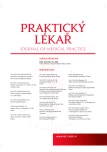Polypharmacy and diabetes mellitus in seniors in social institutions
Authors:
I. Bartošovič 1; K. Zrubáková 2
Authors‘ workplace:
Vysoká škola zdravotníctva a sociálnej práce sv. Alžbety, Bratislava, Rektor: dr. h. c. prof. MUDr. Vladimír Krčméry, DrSc.
1; Katolícka univerzita Ružomberok, Rektor: doc. Ing. Jaroslav Demko, CSc., Fakulta zdravotníctva, Dekan: prof. MUDr. Anton Lacko, CSc.
2
Published in:
Prakt. Lék. 2020; 100(6): 301-305
Category:
Of different specialties
Overview
Introduction: Diabetes mellitus is the most significant metabolic disease in old age.
Methods: As of 31 October 2019, 237 residents with an average age of 80.5 years lived in two facilities for the elderly, 63 (26.6%) out of them men and 174 (73.4%) women. Among seniors, there were 84 residents (35.4%) who had diabetes mellitus and 19 seniors (8%) with pre-diabetic conditions. We divided the whole population into two groups: a group of 103 residents (43.5%) with diabetes and pre-diabetic conditions and a group of the remaining 134 (56.5%) seniors who were not treated for diabetes or pre-diabetic conditions. Data on diabetes treatment, the average number of regular medications, polypharmacy (regular use of 5 or more drugs and regular use of 5 to 9 drugs) and excessive polypharmacy (regular use of 10 or more drugs) were obtained from the population’s medical records and verified in drug books using e-Health. We statistically evaluated the files using Student’s t-test and χ2-test in contingency tables.
Results: In the group of 84 diabetics, 33 seniors (39.3%) were treated with insulin, 25 residents (29.7%) were treated with peroral antidiabetics, 13 residents (15.5%) were treated with a combination of insulin and oral antidiabetics and 13 seniors (15.5%) were without pharmacotherapy. Seniors with diabetes and pre-diabetic conditions regularly took on average more drugs (10.49) than other seniors (7.6). The differences were statistically significant. Five or more drugs were used by 95.1% of the population with diabetes and glucose homeostasis, compared with 81.3% of the population of non-diabetics. Excessive polypharmacy occurred twice as often in the group of people with diabetes and prediabetes (60.8%) compared to other seniors (30.3%).
Keywords:
seniors – elderly – diabetes mellitus – polypharmacy – polypharmacotherapy – institutions
Sources
1. Andreassen LM, Sandberg S, Kristensen GBB, et al. Nursing home patients with diabetes: Prevalence, drug treatment and glycemic control. Diabetes Res Clin Pract 2014; 105(1): 102–109.
2. Fox Ch, Kilvert A. The state of diabetes care in residential homes. J Diabetes Nurs 2016; 20(4): 142–146.
3. Gazdíková K. Prediabetes. Via Pract 2017; 14(1): 16–20.
4. Harris-Kojetin L, Sengupta M, Lendon JP, et al. Long-term care providers and services users in the United States, 2015-2016. National Center for Health Statistics. Vital Health Stat 2019; 3(43): 88. [online]. Dostupné z: https://www.cdc.gov/nchs/data/series/sr_03/sr03_43-508.pdf. [cit. 2020-05-23].
5. Jokanovic N, Tan ECK, Dooley MJ, et al. Prevalence and factors associated with polypharmacy in long-term care facilities: a systematic review. J Am Med Dir Assoc 2015; 16(6): 535.e1–12.
6. Karen I, Svačina Š, a kol. Diabetes mellitus – novelizace 2020. Doporučené diagnostické a terapeutické postupy pro všeobecné praktické lékaře. 2. vydání. Praha: Společnost všeobecného lékařství ČLS JEP 2020.
7. Krčméry S. Diabetes mellitus – osobitosti vo vyššom veku – klinický pohľad. Forum Diabet 2015; 4(3): 157.
8. Kirkman MS, Briscoe VJ, Clark N, et al. Diabetes in older adults. Diabetes Care 2012; 35(12): 2650–2664.
9. Meneilly GS, Knip A, Miller DB, et al. Diabetes in older people. Can J Diabetes 2018; 42(Suppl 1): S283–S295.
10. Ministerstvo práce sociálnych vecí a rodiny SR. Správa o sociálnej situácii obyvateľstva SR za rok 2018 [online]. Bratislava 2019. Dostupné z: https://www.employment.gov.sk/sk/ministerstvo/vyskum-oblasti-prace-socialnych-veci-institut-socialnej-politiky/spravy-soc-situacii.html [cit. 2020-05-23].
11. Munshi MN, Florez H, Huang ES, et al. Management of diabetes in long-term care and skilled nursing facilities: a position of the American Diabetes Association. Diabetes Care 2016; 39(2): 308–318.
12. Národné centrum zdravotníckych informácií SR. Činnosť diabetologických ambulancií v Slovenskej republike 2018[online]. Bratislava 2019. Dostupné z: http://data.nczisk.sk/statisticke_vystupy/Diabetologia/Cinnost_diabetologickych_ambulancii_v_SR_2018_sprava_k_publikovanym_vystupom.pdf [cit. 2020-05-23].
13. Onder G, Liperoti R, Fialova D, et al. Polypharmacy in nursing home in Europe: Results from the Shelter study. J Gerontol A Biol Sci Med Sci 2012; 67(6): 608–704.
14. Sinclair AJ, Paolisso G, Castro M, et al. European Diabetes Working Party for older people 2011 clinical guidelines for type 2 diabetes mellitus. Executive summary. Diabetes Metab 2011; 37(Suppl 3): S27–38.
15. Sinclair AJ. Diabetes in care homes: greater investment in time and expertise required. Prim Care Diabetes 2018; 20(5): 171–172.
16. Štechová K. Prediabetes. Interní Med 2018; 20(4): 183–188.
17. Ústav zdravotnickych informací a statistiky ČR. Zdravotnictví ČR: Stručný přehled činnosti oboru diabetologie a endokrinologie za období 2007–2017. NZIS report č. K/1 (08/2018) 38 s. [online]. Dostupné z: https://www.uzis.cz/sites/default/files/knihovna/nzis_rep_2018_K01_A004_diabet_endokrin_2017.pdf[cit. 2020-05-23].
18. Vaňo B. Demografické výzvy na Slovensku na najbližšie desaťročia. Slov. štat. Demogr. 2019; 29(2): 5–14.
19. Weber P, Meluzínová H, Weberová D. Diabetes ve vyšším věku. In: Matějovská Kubešová H, a kol. Vybrané klinické kapitoly u seniorů. Praha: Mladá fronta 2015; 7–29.
Labels
General practitioner for children and adolescents General practitioner for adultsArticle was published in
General Practitioner

2020 Issue 6
- Metamizole at a Glance and in Practice – Effective Non-Opioid Analgesic for All Ages
- What Effect Can Be Expected from Limosilactobacillus reuteri in Mucositis and Peri-Implantitis?
- Metamizole in perioperative treatment in children under 14 years – results of a questionnaire survey from practice
- Memantine Eases Daily Life for Patients and Caregivers
- Possibilities of Using Metamizole in the Treatment of Acute Primary Headaches
Most read in this issue
- Use of the toe brachial index to detect lower extremity arterial disease in diabetics
- Listeriosis in the Czech Republic and the European Union – recent situation and the risk communication
- Health effects of coal combustion
- Exercise in the treatment of diabetes mellitus
